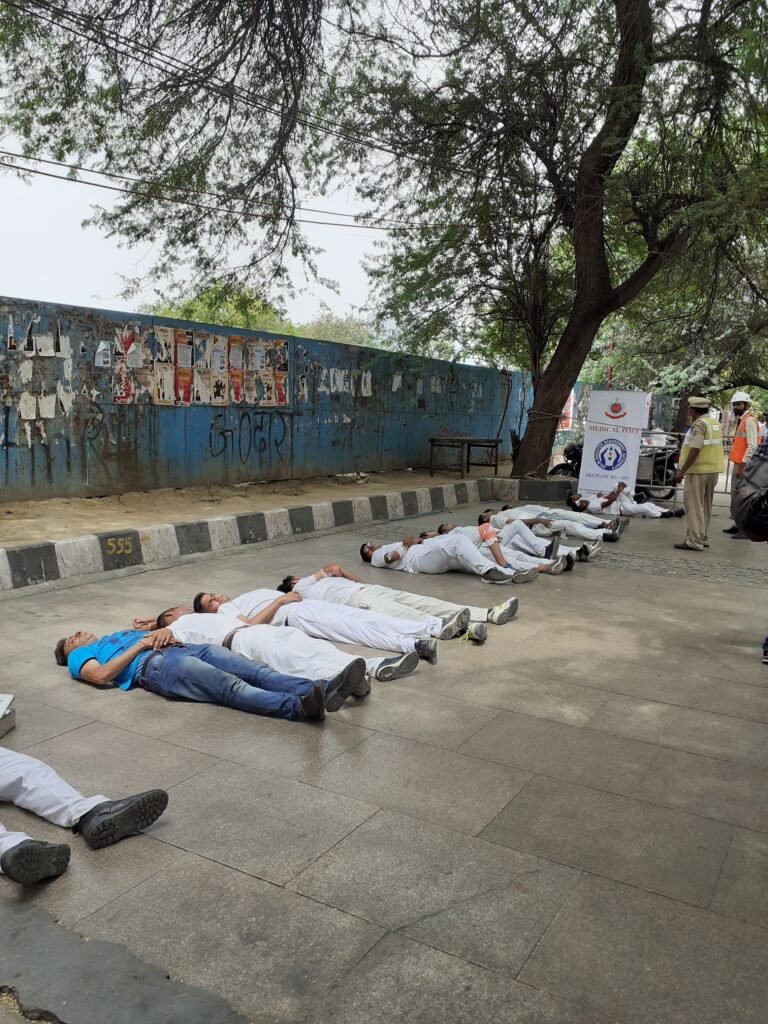EARTHQUAKE DRILL
Earthquake Drill Training: Importance and Benefits for Employees
Introduction
Earthquakes are one of the most devastating natural disasters, causing extensive damage to buildings and infrastructure and resulting in the loss of life and injuries. Earthquake drill training is essential to ensure that individuals in a workplace or other setting can respond quickly and safely in the event of an earthquake. In this blog, we will discuss how to conduct an earthquake drill in the workplace and its importance.
Earthquake Drill Training for Employees
Earthquake drill training for employees is essential to ensure that everyone knows what to do in the event of an earthquake. The training covers essential topics such as drop, cover, and hold-on technique, identifying safe areas, and conducting evacuation drills.
We conduct earthquake drill training to every level of employees in all type of Industries.
Earthquake Drill Training for office Buildings
Office buildings are vulnerable to earthquakes, and it is crucial to have a robust earthquake drill training program in place. Employees must know how to respond quickly and safely in case of an earthquake, evacuate the building safely, and identify safe areas.
Earthquake Drill Training for Construction Sites
Construction sites are high-risk areas for earthquakes, and workers must be adequately trained to respond to an earthquake emergency. Regular earthquake drill training ensures that workers know how to respond quickly and safely, evacuate the site, and identify safe areas.
Earthquake Drill Training for Government Buildings
Government buildings must have earthquake drill training in place to ensure the safety of employees and visitors. The training covers essential topics such as identifying safe areas, conducting evacuation drills, and preparing emergency response plans.
Mock Earthquake Drill Training for Schools
Mock earthquake drill training for schools is essential to ensure that students, teachers, and staff know how to respond to an earthquake emergency. The training covers essential topics such as drop, cover, and hold-on technique, evacuation routes, and safe areas.
Earthquake Evacuation Drill Training
Earthquake evacuation drill training is critical in ensuring that individuals can evacuate a building safely and efficiently. The training covers essential topics such as identifying exit routes, conducting roll calls, and identifying safe areas.
Earthquake Safety Drill Training for Healthcare Workers
Healthcare workers must be adequately trained to respond to an earthquake emergency in a healthcare facility. Regular earthquake safety drill training ensures that healthcare workers can evacuate patients safely and quickly while providing the necessary care.
Earthquake Safety Drill Training for Hotels
Hotels must have earthquake safety drill training in place to ensure the safety of guests and employees. Regular earthquake safety drill training covers topics such as identifying exit routes, using emergency equipment, and conducting roll calls to ensure that everyone is accounted for.
How to Conduct an Earthquake drill in the Workplace
Conducting an earthquake drill in the workplace is essential to test the preparedness of employees and ensure that everyone knows what to do in case of an earthquake. Below are the steps to conduct an earthquake drill in the workplace:
- Notify employees: Notify employees about the upcoming earthquake drill, the purpose of the drill, and what they are expected to do.
- Conduct a briefing session: Conduct a briefing session before the drill to educate employees about the drop, cover, and hold-on technique, evacuation routes, and safe areas.
- Conduct the drill: Simulate an earthquake, and ask employees to drop, cover, and hold-on. Once the shaking stops, ask employees to evacuate the building safely and gather in the designated safe areas.
- Debrief: After the drill, conduct a debriefing session to discuss the strengths and weaknesses of the drill and address any gaps in the emergency response plan.
There are several benefits of Earthquake drills, including:
- Preparation: Earthquake drills help individuals and organizations to prepare for an earthquake by practicing what to do during and after an earthquake. This helps to ensure that people know what to do in a real earthquake, reducing panic and improving response times.
- Awareness: Earthquake drills raise awareness of the risks and dangers associated with earthquakes. This can encourage people to take steps to prepare themselves and their homes, such as securing furniture and creating emergency kits.
- Testing of Systems: Earthquake drills provide an opportunity to test emergency communication systems, such as alarms and public address systems, to ensure that they are functioning correctly.
- Identification of Issues: Conducting earthquake drills can help to identify issues with emergency plans, such as unclear evacuation routes or inadequate supplies, so that improvements can be made.
- Reduction of Damage and Injuries: By practicing earthquake safety measures, individuals and organizations can reduce the risk of damage and injuries during a real earthquake. This can help to minimize the impact of an earthquake on the community and help with a quicker recovery.
Conclusion
Earthquake drills are a critical tool for earthquake preparedness. They help to raise awareness, test emergency plans, identify issues, and reduce the risk of damage and injuries during an earthquake.
EHS CIRCLE INDIA is the Top Fire Consultant or consultancy in Delhi, NCR & India who provides Earthquake Drill training through competent trainers in Pan India.
Contact us for further enquiry

